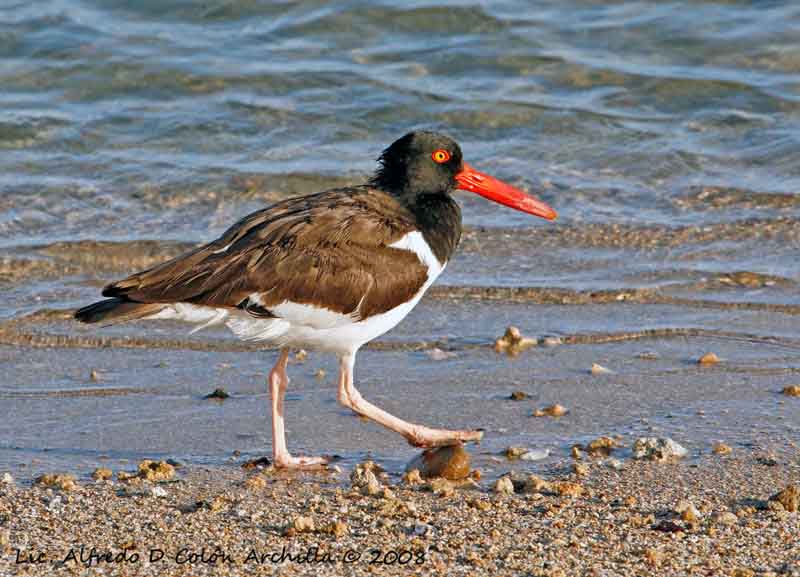
American Oystercatcher
Haematopus palliatus
Charadriiforme Order – Haematopodidae Family
BIOMETRICS:
Length: 40-44 cm
Weight: 400-700 g
LONGEVITE: up to 17 years
DESCRIPTION:
American Oystercatcher has black and white plumage and bright red bill.
Adult has blackish brown upperparts. Rump is white and tail is black. Upperwing shows a broad white band.
Underparts are white with black chest.
Head is black. Eyes are yellowish with red eye ring. Long bill (7,5 to 9 cm) is bright orange-red. Legs are pale dull pink to flesh.
Both sexes are similar.

Juvenile has scaled effect on upperparts, due to buff feathers’ edges. Eyes are dusky. Bill is duller with dark tip. Legs are duller. Juvenile reaches the bright orange-red on bare parts during its first year. It reaches its sexual maturity at about 3 to 4 years.
VOICE: SOUNDS BY XENO-CANTO
American Oystercatcher’s contact call is a loud “peep” often repeated. Both adults utter piping calls during courtship displays. It is a prolonged version of “peep” calls.
Alarm call near the nest is a sharp “keek”. Distress call is a multiple-note of rapid “peep” notes, lower-pitched at the end.
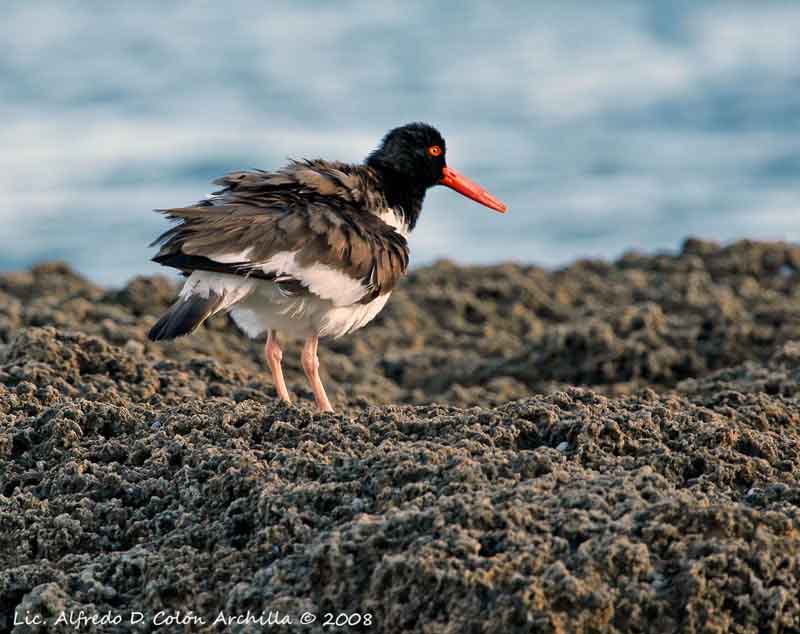
HABITAT:
American Oystercatcher lives in sandy and rocky coasts. They breed mainly in coastal areas, and nest in marsh islands, surrounded by intertidal marsh or mudflats.
It winters in areas when food resources are abundant, such as oyster beds or reefs. It roosts on adjacent areas such as beaches and dunes. It is resident in most parts if its range.
RANGE:
American Oystercatcher breeds along Atlantic and Gulf coasts and in some places in the Caribbean. It is resident on Pacific coasts, from Baja California to Central and South America.
Northern populations may move southwards to winter. They migrate from Massachusetts to Virginia, southwards to south-eastern United States.
BEHAVIOUR:
American Oystercatcher uses its large, heavy bill to pry open bivalve molluscs. It quickly inserts its bill into the open valves and shakes the mollusc in order to sever the muscle holding valves together.
It also may bring an individual mussel in dry location, and uses its bill as a hammer at the point where the muscle is.
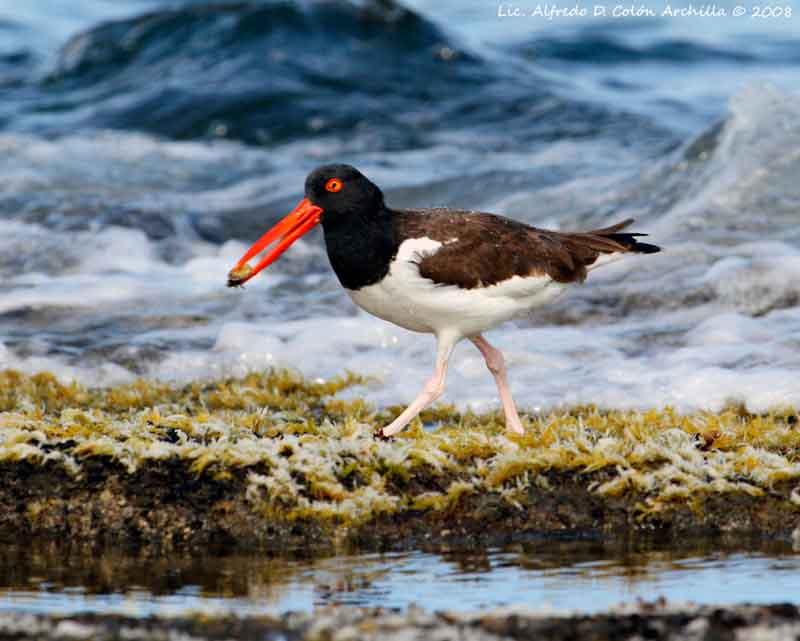
To find its food, it probes into the soil with its long tactile bill. When clam is detected, it uses its bill for pushing it upwards.
American Oystercatcher walks and runs rather than flies. Pairs often roost together. In winter, they roost in large groups.
Territory is defended by both adults, but male in more aggressive. They use piping displays in interaction with neighbouring pairs at the beginning of breeding season.
During territorial conflicts, one bird may throw itself sideways against the ground, in order to dodge the opponent’s bill. Bird bobs the head when disturbed.
American Oystercatchers are monogamous. During courtship displays, usually two birds are walking parallel, giving single pipe note. Then, they stretch neck forwards and down. They also run, side by side, with heads bobbing up and down, and uttering loud piping calls. Both birds frequently stop and turn, while piping. They may take off, flying parallel or close to each other.
At this time, pair may be joined by other birds from adjacent territories. These displays can include three or more pairs. Pair bonds may last their entire life.
American Oystercatcher defends the nest against predators. Adult leave the nest while intruder is still some distance away; then, it walks rapidly before takes off. It performs distraction behaviour, by circling above intruder, giving distress calls.
FLIGHT:
American Oystercatcher flies with deep, rapid wing beats. It uses slow “butterfly flight” in defence of the nest, territorial displays and courtship.
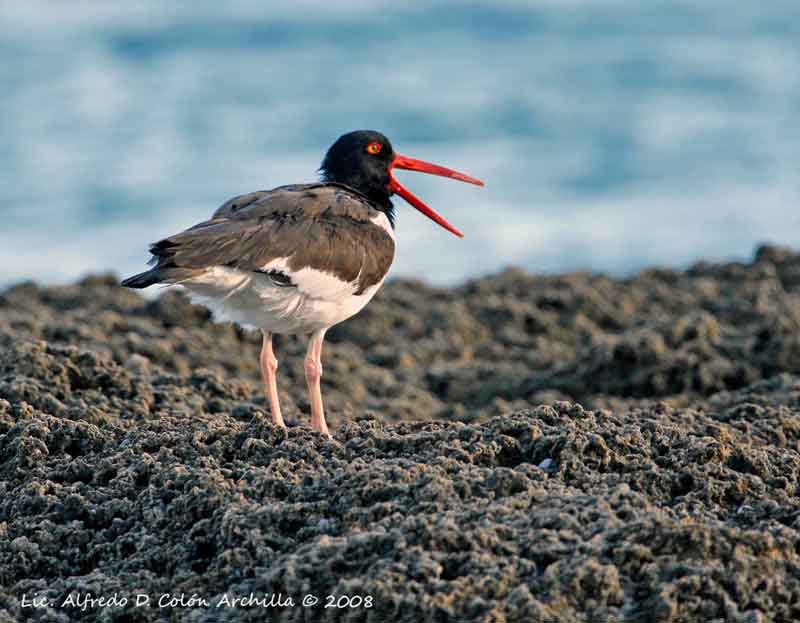
REPRODUCTION:
American Oystercatcher pairs form when birds arrive on territory. Both sexes, but mainly male, begin to scrape a depression for nesting. This behaviour takes part of courtship displays. They can start several weeks before egg laying, and several scrapes may be made.
Nest is a single scrape, a depression in the ground, and sometimes lined with small pebbles or shells. If breeding density is high, birds may from trios, with one male and two females, sharing responsibilities.
Female usually lays 1 to 4 eggs. If there are two females, we can find 5 to 6 buffy-grey eggs, speckled with dark spots. Incubation lasts about 24 to 28 days, and starts when the second egg is laid. Both parents incubate, but female more than male.
Precocial chicks remain in the nest several hours while drying their down. They may run for cover or swim after diving, usually for escape predators. They perform their first flight at about 35 days of age. They become entirely independent for food at about two months after hatching. They are fed by both parents which carry whole food to young, or regurgitate it.
This species produces only one brood per season, occasionally two if the first is destroyed.
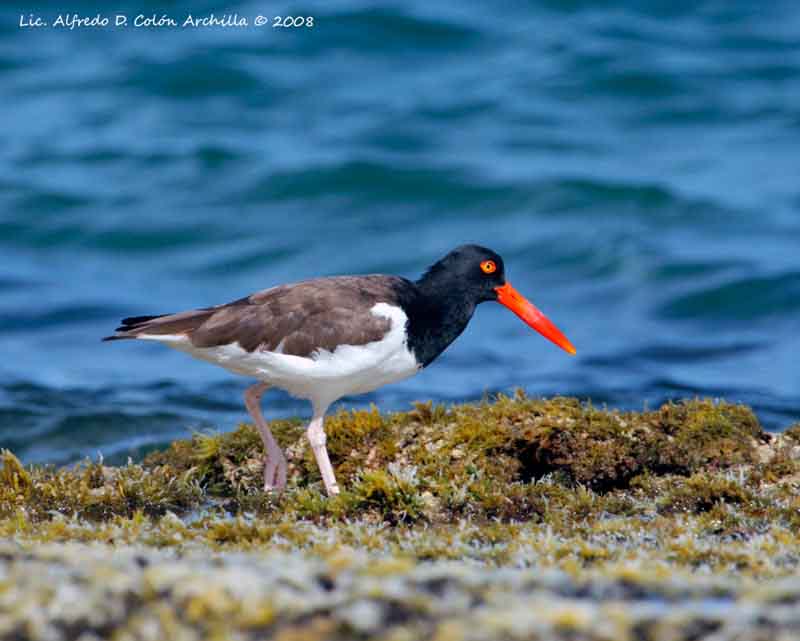
DIET:
American Oystercatcher feeds mainly on shellfish and marine invertebrates from intertidal areas, such as molluscs, bivalves and worms.
PROTECTION / THREATS / STATUS:
American Oystercatcher is preyed upon by red foxes, domestic dogs and cats, rats, American Crows, Gulls, Falcons and Owls.
This species living in coastal areas is vulnerable to human development and marine activities along coasts. It is also threatened by habitat loss on both breeding and wintering areas.
Conservation efforts include protection of breeding and feeding areas, but also include predator control.
Fr: Huîtrier d’Amérique
All : Braunmantel-Austernfischer
Esp : Ostrero Pío Americano
Ital : Beccaccia di mare americana
Nd : Amerikaanse Bonte
Sd : Amerikansk strandskata
Photos d’Alfredo Colón
Puerto Rico Wildlife
Texte de Nicole Bouglouan
Sources :
HANDBOOK OF THE BIRDS OF THE WORLD Volume 3 by Josep del Hoyo-Andrew Elliott-Jordi Sargatal - Lynx Edicions - ISBN : 8487334202
FIELD GUIDE TO THE BIRDS OF NORTH AMERICA - National Geographic Society - ISBN: 0792274512
All About Birds (Cornell Lab of Ornithology)
What Bird-The ultimate Bird Guide (Mitchell Waite)
Wikipedia (Wikipedia, The Free Encyclopedia)